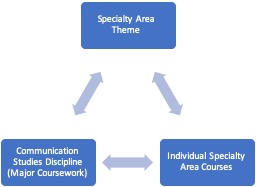Specialty Areas
What is the Specialty Area?
-
The Specialty Area is a required component to earn an Associate’s of Arts degree in Communication Studies at De Anza College (our A.A. degree, not our A.A.T. degree).
-
The Specialty Area is a 12 unit combination of courses from outside the Communication Studies major courses that together create a cohesive theme that serves to expand your understanding of the field of Communication Studies and it’s applications, and also provides insight to a related field that aligns with your specific interests and goals.
Why do I need one?
-
Communication Studies is very wide-ranging academic discipline, and scholars in the discipline will often focus their work in a particular specialty area; the National Communication Association describes several on their website.
How do I satisfy this requirement? What do I do?
-
First, coordinate with a Communication Studies faculty member to create a theme for your specialty area and 12 units of coursework that will create that theme.
- The 12 units of coursework must come from outside the Communication Studies Major courses.
- The 12 units of coursework can satisfy other requirements as well, such as general education requirements or certificate of achievement requirements from a discipline other than Communication Studies.
- The theme of your Specialty Area should align with your interests, passions, and goals in your personal life, academic life, or professional life.
- Please see the National Communication Association website for recommended Specialty Areas, see below for sample Specialty Area course combinations, and meet with a Comm Studies faculty member to discuss your plan for your Specialty Area.
-
Second, write a letter to the Communication Studies Department detailing what your Specialty Area is and how it relates to the Communication Studies Discipline.
-
The letter will ultimately be in a 5-paragraph essay format.
-
You must clearly state which courses (with course number and title) create your specialty area, and how many units each course is credited for.
- You must clearly articulate the title/theme of your Specialty Area.
-
You must clearly articulate how each Specialty Area course is related to the Communication Studies discipline.
-
You must clearly articulate how the Specialty Area courses together create the theme of your Specialty Area

-
You must clearly articulate how this Specialty Area advances your understanding of the Communication Studies discipline.
- Please take a look at the sample student letter as well as the AA Letter Evaluation Rubric for an idea of what the final product should look like.
-
-
Third, submit this letter to the Communication Studies department for recommendations or approval. (This may take several revisions: please begin this process the quarter before your intended graduation).
-
Finally, once your Specialty Area Letter is approved by the department, complete the steps for your A.A. degree application. Hooray!!!
Sample Specialty Areas
| Specialty Area Title | Classes |
|---|---|
| Leadership & Social Change | ICS17, ICS27, ICS 19 (*) |
| Social Media | JOUR90, JOUR61A, JOUR61C, JOUR62 |
| Public Relations & Marketing | JOUR80, JOUR21B, BUS90 (*) |
| Communication Education | CD50, CD68, EDUC1 (*) |
| Interpersonal Communication | CD12, PSYC8, SOC35 |
| Legal Communication | PSYC63, ADMJ5, ADMJ54 (*) |
| Intercultural Communication | CETH11, AFAM10, ASAM1 (*) |
| Environmental Communication | ES1, ES2, ES56 |
| Health Communication | ANTH1, HLTH21, NUTR10 |
| Performance Studies | HUMI1, HUMI2, HUMI5 (*) |
| Organizational Communication | BUS21, BUS56, BUS60 (*) |
| Gender Communication | WMST8, HIST9, ICS26 (*) |
| Political Communication | POLI17, ICS55, SOC5 (*) |
| Visual Communication | F/TV1, F/TV6A, F/TV10 (*) |
* - this particular combination of courses also fulfills most of the requirements for a Certificate of Achievement in that discipline.
Don't feel like you're limited to only the options above! Substitutions and variations are possible to reflect your needs. If you want to do a specialty area outside of the ones listed above, our faculty will work with you to design a specialty area that meets your educational goals.

